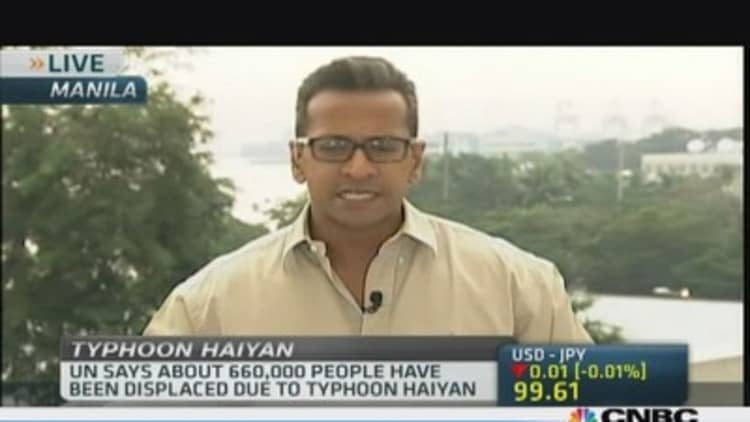At a typhoon refugee center on Samar Island in the Philippines, the traumatized children have slowly begun adjusting to their new normal.
As their parents fret about the future, the children devised a minimalist version of dodgeball, pelting each other with sandals in the absence of balls that got swept away with so much else in Typhoon Haiyan. And when foreign aid workers arrive with provisions, the children spend their time loitering nearby — poking them, giggling and asking questions in halting English like "What is your name?"
(Read more: Aid struggles to reach typhoon-hit Philippines)
But despite the signs of resilience, social workers and parents say the children are newly vulnerable — a reality the Philippines will need to deal with as it stumbles through a flawed relief effort that has failed to provide basics like food and medicine fast enough.
After the immediate needs are met, the country will still be left with challenges that include rebuilding schools and helping children, some of them orphaned, recover emotionally.

"The children you see, yes they are playing, yes they are laughing," said Manneth Catina, 25, a social worker in the hard-hit city of Tacloban on nearby Leyte Island. "But because of the difficult situation, deep down inside they still have fear."
Of the estimated 13 million people affected by the storm, five million are children.
Many lost relatives and friends. Some have terrifying memories of the typhoon's roaring winds, driving rains and a storm surge that swept away homes and pulled people out to sea.
In Tacloban, Gloria Macabasag tells of leaving her three children in the care of her sister-in-law at an evacuation shelter while she and her husband tried to protect their home during the storm. It was destroyed, but they survived. Immediately after the waters subsided, they ran back to the shelter, at the Rizal Central School downtown.
(Read more: Health crisis erupts in Philippines following deadly typhoon Haiyan)
"The kids were crying and looking for us," Ms. Macabasag said. "It looked like they were traumatized."
The school had been inundated as well; she pointed to a door handle to indicate the height — about 3 feet — of the water when it poured in.
To survive, the evacuees in the lower level had to scramble for the second floor of the building, but the wind was so strong through an open-air walkway that they had a hard time moving. Ms. Macabasag said her two youngest children, a 3-year-old girl and a 5-year-old boy, almost drowned, but were pulled from the rising water by adults.
Social workers have told Ms. Macabasag to encourage her children to keep playing and to write and draw to express their feelings about the storm. When she asks her 5-year-old son, Jose Luiz, about what happened, she said, he just cries.
One challenge the country will face as it tries to reopen schools is that many of them, often sturdier than the homes that had surrounded them, are now being used as refugee centers.
Rizal Central School, where Ms. Macabasag and her family are sheltering, is now home to more than 1,300 people. Ms. Macabasag's children sleep on tables in the same classroom they fled to survive the storm.
(Read more: Will typhoon Haiyan derail the Philippine economy?)
She is hoping for the distraction school will provide her children when it reopens. Aid workers, meanwhile, say it is important that children return to school before they become used to being idle.
"We know the longer they don't return to school, the more likely they are to drop out," said Lynette Lim, Asia communications manager for Save the Children. "It's vital we get school started soon as possible."
Ms. Lim is also concerned about child malnutrition, which is already at high levels in the Philippines. Even the aid supplies that finally are reaching communities often do not include some essentials for children, like baby formula.
More from the New York Times:
Calls Grow to Shut Down the Pegasus Pipeline for Good
Thailand's Latest Troubles
The Money Trap
On Friday, Save the Children landed a plane with 100 tons of aid at Cebu, the main staging point for incoming relief supplies. But because there was only one forklift, it took 15 hours to unload the plane, Ms. Lim said.
"It was a very long process with many delays along the way just because the infrastructure at Cebu is not strong enough," she said.
Along with the United Nations Children's Fund, Save the Children has also set up a child-friendly area in a tent at Rizal Central School where children play with toys and do art projects. There are now three such centers in the area and the expectation of many more.
(Read more: How to help Typhoon Haiyan survivors)
"What we found is that children try to entertain themselves, but there's not much to do," Ms. Lim said. "What we want to do is provide structure. We know that what helps children recover from disaster is getting back in the swing of things."
On Tuesday, Ms. Macabasag said Jose Luiz, the child who has been unable to speak about the disaster, had already discovered the area, though it had yet to officially open.
"He thinks it's school," she said. "It's a huge help for the kids."


